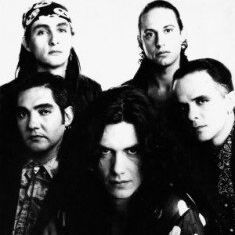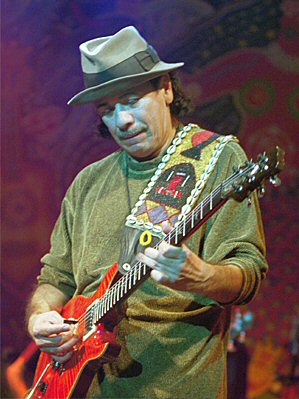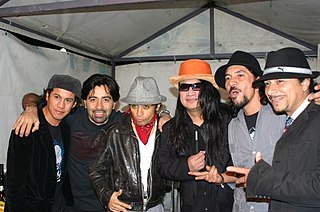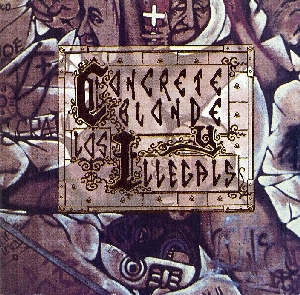Related Research Articles

Chicano rock, also called chicano fusion, is rock music performed by Mexican American (Chicano) groups or music with themes derived from Chicano culture. Chicano Rock, to a great extent, does not refer to any single style or approach. Some of these groups do not sing in Spanish at all, or use many specific Latin instruments or sounds. The subgenre is defined by the ethnicity of its performers, and as a result covers a wide range of approaches.

Café Tacuba, stylized as Café Tacvba, is a band from Naucalpan de Juárez, State of Mexico. The group gained popularity in the early 1990s. They were founded in 1989, before they had the current lineup of Rubén Isaac Albarrán Ortega, Emmanuel del Real Díaz, José Alfredo "Joselo" Rangel Arroyo, and Enrique "Quique" Rangel Arroyo:, their friend Roberto Silva played the keyboards for a short period of time. Since the Cuatro Caminos World Tour, Luis "El Children" Ledezma has played the drums in every concert but is not considered an official member of the band, as well as Ramiro Del Real Díaz, who joined the band as a support musician playing the guitar since 2015.
Latin rock is a term to describe a subgenre blending traditional sounds and elements of Latin American and Hispanic Caribbean folk with rock music. However, it is widely used in the English-language media to refer any kind of rock music featuring Spanish or Portuguese vocals. This has led to controversy about the scope of the terminology.
Concrete Blonde was an American rock band from Hollywood, California. They were initially active from 1982 to 1994, and reunited twice: first from 2001 to 2004, and again from 2010 to 2012. They were best known for their album Bloodletting (1990), its top 20 single "Joey", and Johnette Napolitano's distinctive vocal style.

Caifanes are a rock band from Mexico City. Formed in 1987, the group achieved international fame during the late 1980s and early 1990s. The original line-up consisted of Saúl Hernández, Sabo Romo, Alfonso André (drums) and Diego Herrera. Alejandro Marcovich later joined as lead guitar player. Caifanes' style can be described as a hybrid of British new wave, progressive rock and Latin percussion underscored by deep, somber and Latin American-Mexican Spanish-influenced lyrics and the vocal style of Saúl Hernández. Members of Caifanes have cited The Cure, The Beatles and King Crimson as major influences. Adrian Belew produced their third studio album, El Silencio, and made a guest appearance on the track Piedra.

Fobia is a Mexican rock en español band from Mexico City.

Mexican rock music, often referred to in Mexico as rock nacional, originated in the 1950s. Standards by The Beatles, Elvis Presley, The Everly Brothers, Nancy Sinatra, and Chuck Berry were soon covered by bands such as Los Apson, Los Teen Tops, Los Twisters, Los Hitters, Los Nómadas, Los Rockets, Los Rebeldes del Rock, Los Locos del Ritmo, Los Crazy Boys, and Javier Bátiz, which later led to original compositions, often in English. The group "Los Nómadas" was the first racially integrated band of the 1950s. Their lead guitarist, Bill Aken, wrote most of their original material, including the raucous Donde-Donde, and co-wrote the material for their Sounds Of The Barrio album, which is still being sold. Their 1954 recording of She's My Babe was the first top 40 R&B recording by a Latino band. In the southwestern United States, Spanish guitar rhythms and Mexican musical influences may have inspired some of the music of American musicians Ritchie Valens, Danny Flores, Sam the Sham, Roy Orbison, and later, Herb Alpert. Initially, the public exhibited only moderate interest in them, because the media attention was focused on La Ola Inglesa.

Molotov is a Mexican rock band formed in Mexico City in 1995. Their lyrics, which are rapped and sung by all members of the group, feature a mixture of Spanish and English. The band members also switch instruments and roles depending on what song they are performing.

La Maldita Vecindad y los Hijos del Quinto Patio is a band formed in Mexico City in 1985. They are pioneers of rock en español and one of the most influential rock bands in Mexico.

Rock en español is a term used to refer to any kind of rock music featuring Spanish vocals. Compared to English-speaking bands, very few acts reached worldwide success or between Spanish-speaking countries due to a lack of promotion. Despite rock en español's origins in the late 1950s, many rock acts achieved at best nationwide fame until the Internet consolidated the listeners. However, some rock en español artists did become internationally popular with the help of a promotional campaign from the mid-1980s to the mid-1990s called "Rock en tu idioma". Some specific rock-based styles influenced by folkloric rhythms have also developed in these regions. Some of the more prominent styles are Latin rock ; Latin alternative, an alternative rock scene that blended a Latin sound with other genres like Caribbean ska, reggae, and soca; or Andalusian rock, a flamenco-influenced style that emerged in Spain.
Latino punk is punk music created by Latino people in Latin America and the United States. The angst and protest qualities of punk music and style have had a strong appeal to Latino youth in the U.S., and to the people in Latin America. It is impossible to pinpoint the exact location or moment when Latinos began engaging in the punk subculture. However, Latin American rock began showing aspects of punk music during the mid-1960s with the Peruvian band Los Saicos; this band reflected many aspects of other proto-punk bands such as the Yardbirds. The Saicos were predecessors to some of the most influential proto-punk bands in the U.S., such as New York Dolls, MC5, and The Stooges

An album produced as a joint effort between Johnette Napolitano and James Mankey, previously founding members of alternative rock band Concrete Blonde, and L.A. pachucho punk band Los Illegals. It contains a blend of hard rock and Latin music.
Latin alternative, or "alterlatino", is a brand of Latin rock music produced by combining genres like alternative rock, lofi, chillout, metal, electronica, hip hop, new wave, pop rock, punk rock, reggae, and ska with traditional Ibero-American sounds, in Latin Europeans and Latin Americans countries.
"Pachuco" is a song by Mexican rock band La Maldita Vecindad. It was released in 1991 on their second studio album El Circo (1991).
Mas alla de los Gritos is a 1999 documentary film featuring the Latino/Chicano punk movement from the late 1970s up until the early 1990s. Producer Martin Sorrondeguy singer of hardcore punk bands Los Crudos and Limp Wrist, also founder of record label, Lengua Armada Discos, documentary film director and a prominent figure in both the straight edge scene and the queercore scene, illustrates the repurposing and remixing of punk music in the major Latino cities on the U.S. This one of a kind documentary sheds light on the political D.I.Y. philosophy which aims to empower youth to emancipate themselves from society's oppression. The film is composed of interviews and live performances. The film focuses on the struggle of Latino/Chicano against globalization, poverty, and identity.
Willie Herrón III is an American Chicano muralist, performance artist and commercial artist.
The Brat was a Chicano punk rock ensemble originating from the barrios of East Los Angeles, California. Its three core members were lead singer Teresa Covarrubias, lead guitarist Rudy Medina, and alternate lead and rhythm guitarist Sidney Medina. From their conception in late 1978 to their eventual break-up in 1985, The Brat contributed to the customization and intermeshing of multiple musical and cultural models that culminated in the distinct East Los Angeles, Chicano punk sound.
Rock en tu idioma was a publicity campaign -- resulting in a series of rock albums -- initiated by the BMG Ariola music label, which other labels later also joined, to promote and distribute the music of Mexican, Spanish and Argentinian bands. Between 1986 and 1991 the campaign was part of a musical movement in Latin America, and of the boom that arose from what became known as the Movida Madrileña.

José Luis Paredes Pacho is a Mexican musician, researcher, writer and cultural advocate. He is the founder of the new cycle of Poesía en voz alta Mexican poetry festival, Radical Mestizo's Festival de Mexico music program and founder member of Maldita Vecindad y los Hijos del Quinto Patio where he was drummer during 18 years. He is one of the researchers about Rock music in Mexico and counterculture movements in the country.
References
- ↑ "Los Illegals". American Sabor. Smithsonian Institution . Retrieved July 31, 2018.
- 1 2 Threadgould, Michelle (2016). "Iconic East LA Punk Band Los Illegals on Why Chicano Punk Is an Act of Resistance". Remezcla.
- ↑ Whiteside, Jonny (November 3, 2016). "The 10 Best Bands From East L.A." L.A. Weekly. Retrieved July 31, 2018.
- ↑ Loza, Steven (April 1, 1993). Barrio Rhythm: MEXICAN AMERICAN MUSIC IN LOS ANGELES. University of Illinois Press. ISBN 978-0252062889.
- ↑ David Reyes; Tom Waldman (March 16, 2009). Land of a Thousand Dances: Chicano Rock 'n' Roll from Southern California. University of New Mexico Press. ISBN 978-0826347220.
- ↑ Various Artists (January 13, 1998). "Ay Califas: Raza Rock of the 70's & 80's" (Audio CD). Rhino. ASIN B000003458.
{{cite journal}}: Cite journal requires|journal=(help) - ↑ "Concrete Blonde Y Los Illegals". Archived from the original on May 10, 2008.
- ↑ Doss, Yvette C. (May 3, 1997). "More 'El Lay' Stories". Los Angeles Times. ISSN 0458-3035 . Retrieved July 31, 2018.
- ↑ "Concrete Blonde y Los Illegals Rock L. A." MTV. May 8, 1987.
- ↑ Lopetegui, Enrique (May 3, 1997). "A Chicano Celebration". Los Angeles Times .
- ↑ Jae-Ha Kim (May 4, 1997). "Spin Control". Chicago Sun-Times . Archived from the original on April 2, 2015 – via highbeam.
- ↑ "Concrete Blonde y Los Illegals". AllMusic . Retrieved March 3, 2015.
- ↑ Mexamérica. OCLC 78725248.
{{cite book}}:|website=ignored (help) - ↑ Miller, Tim (June 28, 2000). "A Multimedia Migrant Experience". LatinoLA.
- ↑ Buenrostro, Eliana. "'Destined to Fuck Up': Los Illegals, Chicano Punk and the Immigration Politics and Art of 1980s Los Angeles" (MA Project).
{{cite journal}}: Cite journal requires|journal=(help) - ↑ "Chicano Rock! The Sounds of East Los Angeles". PBS. Archived from the original on December 17, 2008.